Dan Warthen

So who broke Matt Harvey, and what in the world is Dan Warthen doing to fix it? Seriously, Harvey has talked about struggling with his mechanics since the beginning of the year. Nothing has been fixed.
Tonight, Harvey had diminished velocity. His location was off. The immoral Braves offense was making solid contact against him. The Braves came into tonight’s game averaging 3.2 runs per game, and they’ve only hit five homeruns all season. Sure enough, Harvey allowed eight hits, three earned, and two walks with four strikeouts over 5.2 innings. He allowed the immortal Mallex Smith to hit a homerun.
Before the night started, Terry Collins did point out that Harvey was sick. Side note, if he was sick and clearly didn’t have it, why did he go out for the sixth? Anyway, if Harvey’s sick, he does deserve some benefit of the doubt. However, two things should be noted before giving him the benefit of the doubt: (1) the Harvey of old would’ve toyed with no-hitting this team; and (2) this start was not unlike most of Harvey’s other starts. Harvey came into the game with a 4.76 ERA, and he left the game with a 4.76 ERA. Once again, Harvey had a rough sixth.
https://twitter.com/bbtn/status/727670040573706241
As bad a night as Harvey had, Kevin Plawecki had just as bad, if not an even worse night, than Harvey. The third run of the game scored on a Harvey wild pitch. In reality, Plawecki didn’t get down on a pitch in the dirt and let the ball go through the wickets. While stolen bases are also a function of the pitcher’s ability to hold on runners, Plawecki did allow three stolen bases. To be fair, two of them were on a double steal he can no chance.
If that wasn’t bad, Plawecki was terrible at the plate as well. He was 0-2 at the plate. In the fifth, when Asdrubal Cabrera got the Mets first hit off of Matt Wisler, he hit into an inning ending double play. Overall, when the highlight of your day is getting hit by a pitch, you know you had a terrible day.
Speaking of the Mets offense, there were a lot of hard hit balls. Unfortunately, most of them were hit right at someone. Still, the Mets were one-hit, and they struck out four times. Not a good night.
Not a good night for Collins either. He left Harvey in too long. He also failed to make an important challenge. In the fateful sixth, A.J, Pierzynski challenged Yoenis Cespedes‘ arm. Pierzynski was ruled safe on a bang-bang play. There was no challenge.
He was out. pic.twitter.com/8CqQyj1KdA
— metsfan, fully vaxxed and masked (@metsfan) May 4, 2016
Pierzynski would then score on the aforementioned Harvey wild pitch.
Overall, tonight reminded me of that scene in Pleasantville when the basketball team finally lost a game. Everyone stood around saying, “Can’t win them all,” when someone noted that they really had won them all. I really thought the Mets could realistically go 19-0 against this Braves team. They won’t.
Hopefully, the Mets put this ugly game behind them as they march to 18-1 starting tomorrow.
Game Notes: Harvey may or may not have been using chewing tobacco. This would be a good test of the NYC smokeless tobacco ban.
The Mets hired Kevin Long as their hitting coach to help a team that wasn’t hitting. Subsequently, they hired Pat Roessler as the assistant hitting coach. Roessler was hired because of his previous relationship with Long. So far, they’ve worked extremely well together.
Long and Roessler work hand-in-hand to help the Mets batters. For example, they worked in tandem to help Lucas Duda hit lefties last year. It’s helpful to have another voice to bounce ideas of of when trying to help a hitter. When your message isn’t getting through, it’s helpful to have another voice to help deliver the same message. Having both coaches this allows Long to watch video between innings to see both his pitcher’s mechanics and how the Mets’ batters are getting pitched. It also allows Long to delegate Roessler to work with the pitchers on their hitting.
Perhaps it’s time the Mets add an assistant pitching coach to the staff.
This is no slight against Dan Warthen. He is in charge of what is the best pitching staff in baseball. He has not shown anything to lead you to believe his message isn’t getting through or that he should be replaced. With that said, wouldn’t it be beneficial for Warthen to have an assistant coach he trusts and feels comfortable working with help with the pitching staff?
Let’s take Matt Harvey‘s start on Saturday. For the first 4.1 innings, he dominated. Then the wheels came off. For his part, Harvey believes he’s struggled with his command since the season began. As reported by Anthony DiComo of MLB.com, Warthen believes it was as simple as Harvey falling into bad habits in a pressure filled inning:
“You get into a pressure situation, you do fall back into bad habits,” Warthen said. “Essentially, that’s what happened today. This has been Matt’s biggest bugaboo since I’ve had him.”
There are two important things to note here. First, Warthen knows the problem and the solution. Second, Warthen doesn’t know quite how to get Harvey to stop falling into the trap. Quite possibly, this is where a second voice could come into play.
One thing that can’t be discounted is perhaps Harvey was just lucky for the first 4.1 innings. For a player who averages 96+ MPH with his fastball, he was sitting at 94 MPH against the Indians. This is a player who averaged 9.5 strikeouts per nine coming into the season. This year he’s at 4.7, and his season high was the four he had against the Indians. It’s possible the mechanical quirk might’ve been perceptible to an assistant coach watching video in the clubhouse as opposed to a pitching coach watching from the dugout.
Now, the Mets do have a bullpen coach in Ricky Bones. However, he can only help so much. The bullpen coach primarily works with relievers and spends the game in the bullpen. Before and after games, he can be a sounding board for Warthen and/or another voice to help a struggling pitcher if needed. With that said, Bones job as the bullpen coach prevents him from running into the clubhouse to watch video of a pitcher’s last half inning to see the pitcher’s mechanics and his batters are approaching their at bats.
That job would best be done by an assistant pitching coach.
There’s another factor to keep in mind. Warthen is a 63 year old pitching coach with bad hips. He missed some time last year after being brought to the hospital with an accelerated heartbeat. No one knows how much longer he will want to or be able to stay on as the Mets pitching coach. As the organization clearly thinks very highly of Warthen, wouldn’t it make sense for him to groom his successor?
It’s time for the Mets to add an assistant pitching coach.
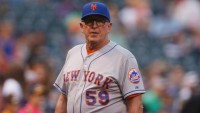
React to last night’s loss the way you want. No matter what your reaction may be, we can all agree that the Mets have some work to do. This includes the pitching staff.
Before last night’s loss, the Mets lead the National League in ERA. After Steven Matz‘s dud last night, the Mets are now ranked sixth. They went from a 2.08 ERA to a 3.40 ERA. It’s a warning of overlying on small sample sizes. It’s also a reminder that it’s really about the process. While it’s a results oriented business, the pitching coach needs to focus on things like the pitcher’s mechanics and not his ERA.
In that respect, Dan Warthen has some work to do as three of his starters have some mechanical issues.
Steven Matz
Last night, Matz was terrible. There are a number of things you can point to as the reason like the long layoff. However, as Kevin Kernan reported in the NY Post, Matz’s mechanics may have been to blame:
He looks like a young guy who needs a month in Triple-A to clean up some things,” one veteran scout at the game told the Post.
Looking at last night’s game, there was no doubt Matz needs some work. He wasn’t fooling anyone last night, and the Marlins were on top of his pitches. Preferably, Matz can do that work with Dan Warthen instead of Triple-A. Regardless of where he does it, Matz needs to need to get himself right.
Jacob deGrom
The talk throughout Spring Training was Jacob deGrom‘s fastball ranging between 91 – 93 MPH. That is down from the 96 MPH fastball he averaged last year. There were a number of reasons posited why that was the case from him starting getting ready for the season later to him saving bullets for the regular season to him getting nicked up a couple of times during Spring Training.
In his first start of the season, deGrom was still averaging 92 MPH. Some said there was no need for caution because he looked dominant at times even without the extra MPH on the fastball. Some later speculated it might’ve been the result of his lat injury. However, on the April 11th edition of MLB Tonight, Pedro Martinez stated that deGrom was dropping his arm angle. It was his belief that if deGrom fixed his arm angle the extra MPH could return to deGrom’s fastball.
Matt Harvey
This season is supposed to be the season for Matt Harvey. He’s another year removed from Tommy John surgery. He’s got his slider back. The only thing he had to worry about was going out there and dominating like he did in 2013.
It hasn’t started out that way. Harvey was 8-0 in April coming into this year. This year he’s 0-2 with a 4.63 ERA and a 1.463 WHIP. At times, he seems to have difficulty locating pitches. Harvey isn’t blaming his bladder problems. As Neil Best of Newsday reports on Opening Day, it’s a mechanical issue:
“I felt alright,” Harvey said. “There were times I felt fine and other times when it was hard finding a rhythm and getting my release point.”
After Sunday’s loss to the Phillies, Harvey’s day changed on one pitch he left out over the plate. Again, as Kevin Kernan of the NY Post reported, it was a mechanical issue as, “Harvey said he didn’t get the arm extension on the killer 1-2 slider.” As Kernan further reported the coaching staff is concerned enough for Dan Warthen to start “studying film to see what the issue is with Harvey.”
Dan Warthen is going to study film for at least three of his starters. Fortunately, it is still early in the season. The Mets have plenty of time to figure things out. The pitching is going to be there, and yes, the offense will as well. However, while the offense is figuring things out, the Mets need their pitching. As we saw last year, this Mets staff can keep even the most abysmal of offenses afloat. As we saw last year, the Mets pitching can carry them to the World Series.
It’s the Mets pitching that is going to win them the World Series this year.
Editor’s Note: this article first appeared on metsmerizedonline.com
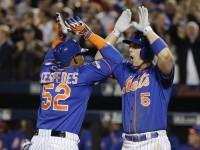
No one anywhere will suggest that a team’s Spring Training record is indicative of anything. In fact, statistics and results shouldn’t be over analyzed. With that said, there are some results from Spring Training that can reasonably be cause for alarm.
deGrom’s Velocity
Last year, Jacob deGrom‘s fastball averaged 95.81 MPH. This Spring, deGrom’s fastball has generally been between 91 – 93 MPH.
There are reasons for this. He took additional time off in the offseason with last year’s increased workload. He dealt with a minor leg injury. He had to get a new mattress because the old one gave him a stiff back. His wife is expecting and may deliver any day now. Overall, there have been a series a distractions and very minor injuries. Through it all, he hasn’t found his fastball.
Now, deGrom can probably still get people out with less stuff, but it’s not ideal. With a slower fastball, he can still be good, but he won’t be dominant. He may find his fastball in real games whether it is due to velocity or him holding something back in Spring Training. However, as of today, he is throwing 91-93 MPH, and Spring Training is effectively over. It’s fair to be concerned about deGrom’s velocity.
Cespedes’ Power
When Yoenis Cespedes came to the Mets, he put on a display. Up until 2015, he averaged 24 homers a year. In two months with the Mets, he hit 17 home runs.
This Spring he has hit one homerun. He has been working with Kevin Long to change his approach at the plate. He’s had stiffness in his hip. In the NLCS, he had to pull himself from a game with an aggravated AC joint in his right shoulder. That same right shoulder has been bothering him this Spring.
Now, Cespedes is a streaky hitter who can start hitting home runs all over the place once the season begins. His one homerun came in the last Spring Training game, which is hopefully a sign of good things to come. However, at this point, we cannot dismiss the possibility that the decreased power is from this new approach, or his wonky right shoulder, or both.
Bastardo’s Control
With Antonio Bastardo, there are two issues you have with him: (1) he pitches well every other year; and (2) walks.
For starters, based upon the pattern of Bastardo’s career, he will have a rough 2016. In even numbered years, his ERA+ has been under 100 and his ERA has been 3.94 and above. In odd numbered years (where he played a full season) his ERA+ is 129 and above, and his ERA has been 2.98 and below. As we know, this is an even numbered year, and his Spring hasn’t instilled any confidence that the pattern will change.
One big reason why is Bastardo has walked 5 guys in 10.1 innings this Spring. Both Terry Collins and Dan Warthen are worried about his command. Warthen has been working with Bastardo on his mechanics to no avail. It’s a problem that needs to be fixed because Bastardo has walk issues. In his career, he averages 4.1 BB/9 (not good) in odd numbered years. In the dreaded even years, he averages 4.7 BB/9 (worse). Right now, Bastardo has given no indication this odd year – even year pattern won’t continue.
Conforto Hasn’t Played RF
Right now, the Mets have five outfielders capable of playing everyday. Of those five, Curtis Granderson, Alejandro De Aza, and Juan Lagares have platoon splits. Last year, Michael Conforto was only allowed to face righties the vast majority of the time.
The plan for Conforto this year was to let him play everyday. Having Conforto play everyday and not play in RF is going to be difficult. When the Mets face a lefty, especially a tough lefty, it’s likely Collins will want Lagares in CF and Cespedes in RF. That means the left-handed batter will have to play RF. In that circumstance, Collins will be more likely to play Granderson or De Aza as both have experience in right field.
For his part, Conforto hasn’t played right field in his very limited time as a professional. He’s worked there during practices in Spring Training, but he has not played right field in a game. There is simply no substitute for in-game experience. It’s likely the lack of game experience may hold him back. It’s likely Collins will not play Conforto in right.
By not playing Conforto against lefties, they may be hampering his development. Furthermore, the Mets may not be putting their best lineup out there against lefties.
David Wright’s Back
To be fair, when David Wright returned from the DL last year, he hit .277/.381/.437 in 30 games. If Wright can keep that up – he’s a career .298/.377/.492 hitter – there’s no reason to be concerned about him. Even better, he had a full offseason to adequately prepare for 2016.
However, Wright had trouble playing three games in a row after his return from spinal stenosis. It wasn’t until this week that Wright dared to play four games in a row in Spring Training. At the end of the day, no one knows how many games Wright can play in 2016. Everything is in estimate or a guess whether it be 130, 100, 81, 10, etc. That’s a problem.
Wright is the Mets’ captain. He’s the best option at third base. He’s still a good hitter who gets on base more than anyone else in the lineup. Whether the Mets or anyone else will acknowledge it, the team needs him. Unfortunately, no one knows how much Wright can give them.
Overall, there are things about this Spring that should give Mets fans cause for concern. The record isn’t one of them. It’s not the production. It’s the team’s general health and preparedness for the 2016 season.
Despite these issues, the Mets still look to be a great team that can not only compete for a playoff berth, but also win the World Series.

In honor of Pi Day, let’s look at all the things to look forward to during the 2016 season:
3.1 – Mike Piazza
This summer Mike Piazza is going into the Hall of Fame as a Met. He’s the first Mets position player to do so. The following weekend, he will also be the first Mets position player to have his number retired. He will forever be remembered for all of his homeruns, especially the homerun after 9/11. More importantly, he will forever be a Met.
41 – Tom Seaver
Seaver is the greatest Met to ever wear the uniform, and perhaps, the greatest right handed pitcher of all time. He was rightly dubbed “The Franchise.” With him, he began the aura of the Mets always having good pitching. This year his mantle will be picked up again by a dominant young staff reminiscent of the pitching staffs Seaver was a part of back in his day.
59 – Antonio Bastardo
Bastardo is one of a few key free agents the Mets added this offseason. Last year, the Mets had bullpen problems forcing them to overuse Jeurys Familia and trade a lot of good young pitching away to build a bullpen around the trade deadline. This year, Bastardo is a key arm in what appears to be a bullpen worthy of holding down the leads handed to them from their dominant starting pitchers.
26 – Kevin Plawecki
Plawecki had a rough 2015 whether it was because of him being rushed to the majors too soon or him needing sinus surgery. Given Travis d’Arnaud‘s injury history, it is very possible Plawecki is going to get another shot at being the Mets starting catcher next year. At some point, he will be called upon to not only continue his tremendous work as a receiver, but also being a more potent bat to the Mets lineup.
5 – David Wright
The biggest question mark in the 2015 season is how much David Wright can play and how effective he can be over the course of a 162 game season. Wright is the team leader and Captain, and they’re going to need him. At the end of 2015, he showed he can still hit and be an important part of the Mets. They’re going to need him at some point next year.
35 – Logan Verrett
After losing Verrett in the Rule 5 draft last year, he’s back with the Mets organization. Last year, he was an important swing man. He was first a bullpen arm and later a spot starter who gave a young pitching staff some rest before the postseason. In 2016, Verrett is likely to serve a similar role regardless of where he starts the year. At some point, the Mets will need him, even if it’s just to get the starters some rest before another postseason run.
89 – The Closing of a Window
After the Mets lost in the 1988 NLCS, there was no reason to believe that was the end of their window. There were veterans on the team, but there were also prospects behind them and rising stars on the team. There was still the pitching. It’s a stark reminder that when the window is open, you do everything you can in that timespan. You never know when that window closes.
79 – Paul Sewald
Sewald is just one of a number of Mets pitching prospects who are chomping at the bit to get called-up to the majors. Sewald has had a 1.83 ERA in his entire minor league career. If he continues pitching this well, he very well might get a call-up in the event there is an open bullpen spot this year.
32 – Steven Matz
In Matz’s first two career starts, he was incredible on the mound and at the plate. Even after his injuries, he has shown flashes of brilliance. He’s an early leader in the Rookie of the Year race. He’s primed to become the next great Mets starting pitcher. In 2016, he needs to stay healthy and take that next step.
38 – Dan Warthen
Warthen and the entire Mets organization have been blessed with amazing pitching. It’s encumbent upon Warthen to not only help each of these pitchers take the next step in their development, but also to help keep them healthy over the course of a full season.
4 – Wilmer Flores
We end with Flores, who was the last Mets to bat in the 2015 World Series. Flores was the player who cried at the possibility of leaving the Mets to a fan favorite. He has gone from the starting shortstop to a utility/platoon player. The 2016 Mets are a heavy left-hand hitting team. Flores can balance this out in his role as a super sub.
He’s also the first choice for third base in the event that Wright needs to sit or go on the DL for long stretches of time. He’s the primary backup at every infield position. He’s going to be an extremely important piece for the Mets.
They are all important actually. As we saw in 2015, a team will have to go deep into their roster at times. However, by building a strong 25 and 40 man roster, as the Mets have now, you give your team the best chance to make it to the postseason. Hopefully, the Mets can come full circle (pi pun) in 2016, and win the World Series.
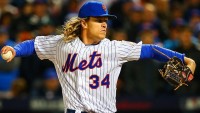
Going into the 2016 season, there is one fear each and every Mets fan has. We dare not speak its name, but that doesn’t change the fact that it’s still present. That fear is that a pitcher will get seriously injured.
Looking at this year’s list of pitchers who could befall the dreaded “Verducci Effect,” Noah Syndergaard headlines that list. If Syndergaard was to suffer a season ending injury requiring Tommy John surgery? it would greatly hinder the Mets chances of winning not only the World Series, but also making it to the postseason. It’s something that not just Mets fans fear, but as Anthony DiComo of MLB.com reports, Syndergaard fears it also:
I’ve thought about it quite a bit. But I trust myself to put my body in the right situations to be able to perform at a healthy level.
The fear is justified. Syndergaard threw 65.2 innings more last year. He throws over 95 MPH more than anyone in the game. He’s working to add the fabled Warthen Slider to his already dominant repertoire. Name a risk factor for UCL years requiring Tommy John surgery. Syndergaard meets most if not all of them.
One risk factor not readily discussed is the team he plays for. Look at the projected Mets rotation when healthy: Matt Harvey, Jacob deGrom, Noah Syndergaard, Steven Matz, and Zack Wheeler. Put aside Syndergaard for a moment. What do the other four have in common? They are all hard throwing pitchers under the age of 30 who have already had Tommy John surgery.
Go outside this group. Since Warthen took over as the Mets pitching coach, the following homegrown Mets have sustained arm injuries: Jon Niese (shoulder), Dillon Gee (shoulder), Jeremy Hefner (two Tommy John surgeries), Rafael Montero (shoulder), Bobby Parnell (Tommy John), Josh Edgin (Tommy John), Jack Leathersich (Tommy John). There are more, but you get the point.
Now, is this an organizational problem since Warthen took over, or is it just bad luck? Could this all have been avoided? Back in the 60’s and 70’s the Mets developed pitchers like Tom Seaver, Jerry Koosman, Nolan Ryan, and Jon Matlack. These pitchers threw more innings than the pitchers today, and yet, Matlack was the only one of this group that suffered an arm injury.
In the 80’s, the Mets had Dwight Gooden, Ron Darling, Sid Fernandez, Rick Aguilera, Randy Myers and David Cone. Of this group, only Doc and Cone had arm issues. It should be noted that Doc had many other issues as well, and Cone’s problem was an aneurysm later in his career.
In the 90’s, Generation K was a bust, and the Mets haven’t developed the caliber of starting pitchers like they have in the past until now. However, this generation seems to befall injuries far more often than their predecessors. Is it organizational? Is it bad luck? Is it preparation? For his part, Harvey wonders what if:
I think now, there are things I could have done better in high school or in college to maybe prevent it. But I don’t know. I’m not saying [Syndergaard] works that much harder than everybody else, because we all work hard. I think as time progresses, guys pay more attention to stretching the shoulder, strengthening the shoulder. If I could go back — I don’t know if this would’ve prevented me from having [surgery], but if I could go back and really do 20 extra minutes of stretching and arm care, you never know what could happen.
That’s the thing. We really don’t know why one guy suffers elbow and shoulder injuries while others don’t. Is it preparation? Is it good genes? Is it just good luck? Much time, energy, and money has been spent on this issue, and yet pitchers still get injured. Pitchers get injured despite teams doing everything in their power to try to prevent it.
It will help Syndergaard being in a clubhouse with players who have had Tommy John surgery. They each will have advice for him on why they suffered the injury and what they could’ve done differently. More importantly, Syndergaard appears to be a hard worker who takes the health of his arm very seriously. There is no doubt he is doing everything he can do to avoid the dreaded Tommy John surgery.
Based on what we’ve seen, if anyone can avoid it, it’s him.
Editor’s Note: this article was first published on metsmerizedonline.com
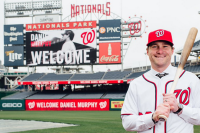
In about one hour, the Mets will play their first Spring Training game of the season. It also marks the first time the Mets will face Daniel Murphy as a member of the Nationals.
It’s a good thing the game will not be televised because I’m not sure my eyes can handle it. I’m hoping the sound of Howie Rose on the radio will prevent my ears from bleeding. For everything Murphy did for the Mets, he’s now with the Nationals. His reward is a big contract and the right to face Mets pitching 19 times a year.
https://twitter.com/bbtn/status/704040843628380160
It’s going to be interesting to see how it plays out over the course of the season. The Mets have three legitimate aces and two pitchers who have the talent to develop into aces. They’re going to strike out a lot of people over the course of the season again. They’re going to give hitters fits again.
However, as we learned over the past seven plus years, Murphy is not your average player. At times, he would leave you scratching your head. As much as I wish him good luck and want him to succeed, I hope he won’t leave Mets fans scratching their heads 19 times this year.
Murphy worked with Kevin Long to increase his power while cutting down on his strikeouts. Last year, Murphy was the toughest batter to strike out in the major leagues. For all the talk about the Mets throwing 95+ MPH, it might not work as well against a contact hitter like Murphy. In fact, Murphy has “an extremely low likelihood to swing and miss” at fastballs. When Murphy faces a fastball, he tends to be aggressive, make contact, and generate some power.
The next best pitch Mets pitchers are said to have is the slider, or as it has been named, the “Warthen slider.” Murphy is more apt to swing and miss against sliders than any other pitch. With that said, Murphy generates more power against sliders than any other pitch.
So as we saw in the postseason, Murphy may prove to be the kryptonite against the Mets superhuman pitching. It’s going to be tough watching Murphy attempt to recreate his October run 19 times during the regular season. It’s going to be tough to watch.
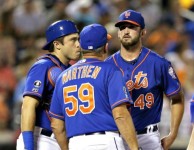
Back in the 90’s when the Braves had Glavine, Maddux, and Smoltz, Leo Mazzone was hailed as a genius. When he went to the Baltimore Orioles, not so much. Rick Peterson was a genius with Hudson, Mulder, and Zito. With the Mets, he was a scapegoat. He was replaced with Dan Warthen.
Now that the Mets have Matt Harvey, Jacob deGrom, and Noah Syndergaard, Warthen has gained some notoriety. We now hear about the “Warthen Slider.” As is the case, when you get a trio of young aces, all the fame is going to come your way. They point to certain things you do that makes great pitchers great. Typically, pitching coaches get a lot of praise when they have great pitchers. Warthen, who had survived two GMs and two managers, is no different. How good is he really? Perhaps, we are about to find out.
This past offseason the Mets traded Jon Niese. He was once regarded well enough to receive a five year contract extension with two additional team options. Overall, Niese was somewhat disappointing. He’s had shoulder problems. He was 61-61 with a 3.91 ERA and a 1.361 WHIP. I believe it’s fair to say the Mets expected more and didn’t receive it. Now, Niese is a Pittsburgh Pirate where he is now joined with well regarded pitching coach Ray Searage.
Searage is fast developing a reputation as a pitching guru. Unlike most pitching coaches, it’s not because of who he has, but what he does with what he has. Here’s an example of some of his success stories:
- 2012 Twins/White Sox 6-12, 5.34 ERA, 1.468 WHIP
- 2013-2015 Pirates 35-25, 3.26 ERA, 1.241 ERA
- 2011 Yankees 11-11, 5.15 ERA, 1.434 WHIP
- 2012-2013 Pirates 26-21, 3.41 ERA, 1.228 WHIP
- 2014 Phillies 8-18, 4.59 ERA, 1.409 WHIP
- 2015 Pirates 9-7, 3.18 ERA, 1.360 ERA
- 2015 Mariners 4-6, 4.64 ERA, 1.408 WHIP
- 2015 Pirates 7-2, 1.85 ERA, 1.026 WHIP
As noted above, Searage’s next project is Niese. He’s coming off of what might be perhaps the worst year of his career where he went 9-10 with a 4.13 ERA and a 1.398 WHIP. Searage has his work cut out for him, especially with a head strong pitcher like Niese. For his part, Niese is seeing an opportunity for improvement with a superior Pirates defense. Is the Pirates defense Searage’s equivalent to Warthen’s slider? Who knows?
At the end of the day, it’s a results based business, and Searage has done something with his pitchers to coax better results than they have elsewhere. If that continues, Niese is about to have the best year of what has so far been a very disappointing career. It’ll be another pitcher that Searage has been able to reach that other pitching coaches couldn’t.
If that’s true, it doesn’t make Warthen a bad pitching coach. Rather, it shows that like this who have come before him, his perceived skill is more closely tied to the skills possessed by his pitching staff.
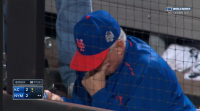
The Mets lost the World Series 4-1. The Mets easily could’ve won the series in the reverse. The difference? The Royals executed in late innings. Terry Collins was terrible. The Royals got a little luck. It wasn’t supposed to go this way. Not this series. Not tonight.
This was the moment Matt Harvey we all imagined when he first came up and pitched against the Diamondbacks. This is the moment we anticipated when Harvey started the All Star Game at Citi Field. We were left dreaming of it when he missed all of 2014 while he was rehabbing from Tommy John surgery.
My God was he awesome. Awesome may be overused, but I can’t think of a better word. I’m not sure a word exists to describe how incredible Harvey was. He went 8+, five hits, two earned, two walks, nine strikeouts.
For all the narrative thrown his way during the innings limit drama, he promised he would be here when the time called for it. Terry Collins tried to take him out of the game before the ninth. Harvey heard the news from Dan Warthen, and he went over to Collins and told him he’s not coming out of the game. He then threw in a lipper and charged out to the mound. You don’t get more old school than that.
Unfortunately, it was the wrong decision. Harvey allowed a leadoff single to Lorenzo Cain followed by a stolen base and a Eric Hosmer double. Familia got a groundout sending Hosmer to third. Then the Mets late inning defense showed its ugly face again. Salvador Perez hit a groundball to David Wright. Wright looked back at Hosmer, but it wasn’t enough. Hosmer took off with Wright’s throw, and he scored on a poor Lucas Duda throw. Blown save. Tie game.
It certainly highlighted the fact that Terry Collins left Harvey in a better too long. It highlighted the poor offense with four double plays off of the grieving Edison Volquez. The only offense the Mets could muster was a Curtis Granderson leadoff homerun and a Duda sacrifice fly. The latter being the only run scored when the Mets had the bases loaded and no out. The first out of that inning came on a Yoenis Cespedes popout after he fouled a ball off his knee. He would have to leave the game after the AB.
For the second straight game Familia got hit with the blown save that wasn’t his doing. He got the groundball. He did buckle down, got out of the ninth, and shut down the Royals in the tenth. Jon Niese kept it tied. Addison Reed didn’t.
Perez leadoff with a single that dropped right on the right field line. Jarrod Dyson pinch tab and stole second. Travis d’Arnaud had no shot. With the way he’s throwing right now, he couldn’t throw out Sid Bream. Dyson would score on a Christian Colon single. Naturally, it was Colon’s first at bat in the playoffs.
Of course Daniel Murphy made another error. Of course Hansel Robles went unused again.of course Collins would wait for it to be 4-2 before lifting Reed. Of course Bartolo Colon would allow a bases clearing double to Lorenzo Cain. The game was out out of reach at 7-2.
Wade Davis came in, and the Mets went quietly into that good night. Duda struck out. d’Arnaud struck out. Michael Conforto singled leaving Wilmer Flores to make the last out. He struck out. Fittingly, it was his final at bat that left us all in tears.


